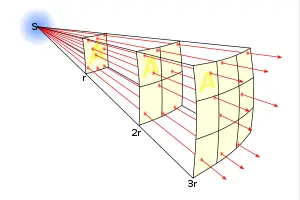Areas of application
In particular the inverse-square law applies in the following cases: doubling the distance between the light and the subject results in one quarter of the light hitting the subject.Gravitation
Gravitation refers to the attraction between two objects with mass. This law states:The gravitation attraction force between two 'point masses' is directly proportional to the product of their masses and inversely proportional to the square of their separation distance. The force is always attractive and acts along the line joining them.
If we want to calculate the attraction between massive bodies, we need to add all the point-point attraction forces vectorially and the net attraction might not be exact inverse square. However, if the separation between the massive bodies is much larger compared to their sizes, then to a good approximation, it is reasonable to treat the masses as point mass while calculating the gravitational force.
This law was first suggested by Ismael Bullialdus but put on a firm basis by Isaac Newton after Robert Hooke proposed the idea in a letter to Newton. Hooke later accused Newton of plagiarism.
